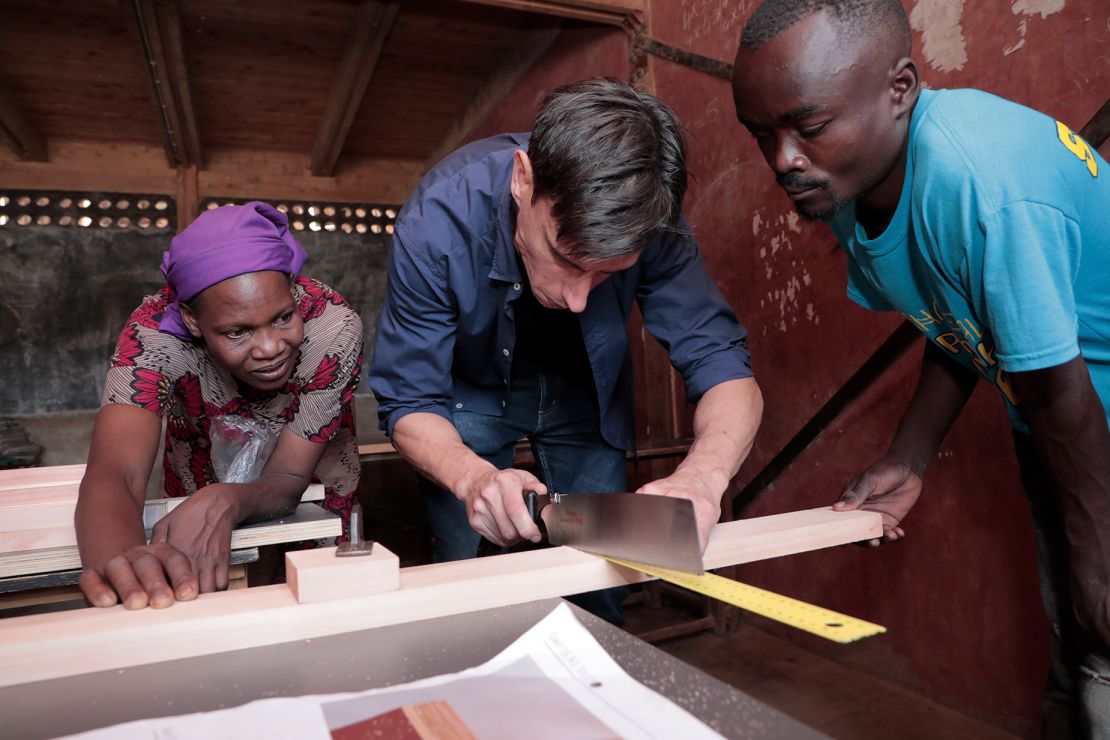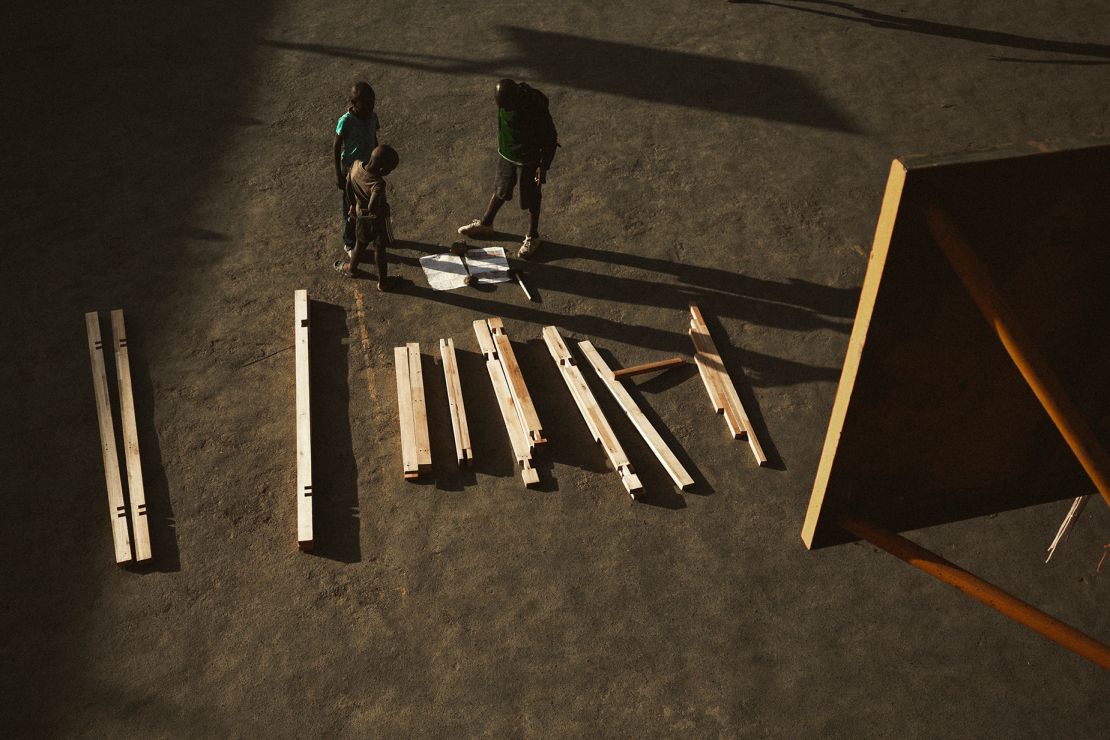Editor’s Note: Design for Impact is a series spotlighting architectural solutions for communities displaced by the climate crisis, natural disasters and other humanitarian emergencies.
When Italian designer Giacomo Moor was tasked with creating furniture for a school in a slum of Nairobi, Kenya last fall, he knew instantly what he wanted to make: Pieces that were functional, straightforward and easy to assemble.
“‘Simplification’ was the word that immediately came to mind,” he said during CNN’s visit to his studio in Milan, Italy. “I knew I had to stick to the basics and think of the whole production in an elemental way.”
The resulting range of modular bunk beds, benches and tables is certainly simple in both construction and design. Moor’s furniture can be built on-site using wooden pieces which locals can cut themselves according to plans. Assembly requires only a few basic tools — a chisel, a carpenter’s square and a pencil — thanks to an adaptable system of interlocking joints.
Comprising clean lines and no decoration, the items’ utilitarian aesthetic hasn’t stopped them becoming a point of pride for students at the Why Not Academy, the primary school they were designed for, Moor said.
“It’s a design conceived to work for the community,” he added. “One that puts function first yet doesn’t compromise on form. I think that’s all there is to it. A humble idea.”
Building for — and with — communities
Moor’s project, dubbed “Design for Communities,” resulted from his collaboration with LiveInSlums, an Italian NGO that works in informal urban settlements around the world. The organization’s director, Silvia Orazi, said it was important that people at the school in Mathare, one of Nairobi’s oldest slums, participated in the furniture-making process and have a say in how their spaces are designed.

“We don’t want to come in, ‘fix’ whatever issue is at hand and leave,” Orazi told CNN in a phone interview. “The whole point of LiveInSlums is to act alongside the residents, to guarantee that change takes place on their own terms.”
The NGO invited Moor to Kenya’s capital last year to assemble the first prototypes alongside a group of eight locals.
“I went with the brief and a few sketches,” the designer recalled. “But the assembly work was done as a collective exercise. I ended up only spending three days at the school, so really, the construction of each piece was completely done by the guys I worked with.
“Ensuring they could build the pieces autonomously was key,” he added. “I only provided the blueprints.”
Kevin Ochieng, a tile maker by trade, was one of the workers who participated in the prototype-building. “After Giacomo explained the construction steps for the furniture, it was fairly easy to get going without him,” he told CNN over the phone from Mathare. “The whole process was very intuitive. It only took one day to learn, which was quite surprising.”

Back in Italy, Moor manages a multidisciplinary team of wood-makers at his Milan studio, which doubles up as a workshop. A carpenter by training, the designer’s hands-on approach is precisely why LiveInSlums chose him for the project, Orazi said.
“He was the perfect candidate for us, because he understands wood and knows how to work with it,” she added. “In Mathare, we don’t have access to a lot of other materials, so we had to make sure the creative involved would be comfortable within those confines.”
Once Moor returned to Italy, Ochieng, who had never worked with wood before, sent the designer videos and photos on Instagram to check that they were still getting it right. “He would reply, and we would keep building,” Ochieng said. “It was all very smooth. It made me feel quite proud how quickly I mastered it, because it’s not really my area of expertise.”
To date, the Why Not Academy has installed a dozen of Moor’s items in its canteen and dormitory.
A quiet functionality
The designer’s glue-free joints were inspired by the carpentry techniques he has long used in his studio. “Interlocking joints are often used in cabinets because of their strength and attractiveness,” Moor explained. “I reinterpreted them in a way that would require just a handful of tools and simplified the whole technique to the extreme. It’s kind-of like building something out of Lego.”
Although the joints can be secured without the need for metal fasteners, Moor asks those assembling the furniture to knock four supporting nails into each item at the end “for extra safety,” though “they actually aren’t a ‘must’ in terms of structural stability,” he added.

“I wanted to avoid having visible nails or screws, because even those can be difficult to come by in a context like Mathare’s. Each element had to be strictly necessary. Nothing superfluous.”
In the planning phase, the designer researched what kind of wood would be readily available in Mathare — namely eucalyptus — and conceived the pieces accordingly to ensure long-term sustainability and scalability. The individual wooden parts can be replaced if damaged or weathered, and may even be used in different types of furniture, as needed.
And despite the basic designs, appearance mattered, too. “It was important to me to provide something that, while aesthetically simple, would still look good,” Moor said. “I think the joints’ padlock system achieves that. Dependable design doesn’t have to be ugly.”
Solid and streamlined, the furniture range has since found new users beyond the Why Not Academy, with Moor selling both assembled and disassembled versions to private customers in Europe. (Ten percent of the profits from these sales goes to the Nairobi school via LiveInSlums, he said.)
Moor hopes his furniture can be used in other parts of the world with limited resources. For now, however, he’s focused on his next LiveInSlums collaboration, which will see him returning to Mathare in January to redesign the school’s kitchen.
“I’d like the kitchen to become more interconnected with its surroundings, and keep that same simplified approach to design,” he said. “You really don’t need complex materials and elaborate extras to create something good.”



